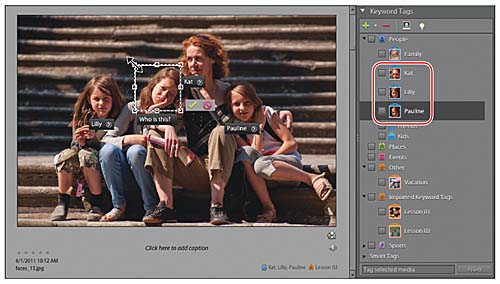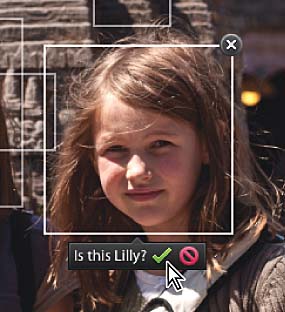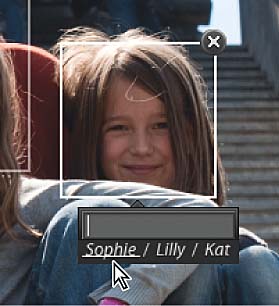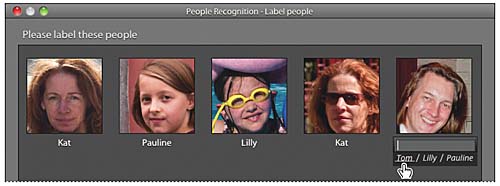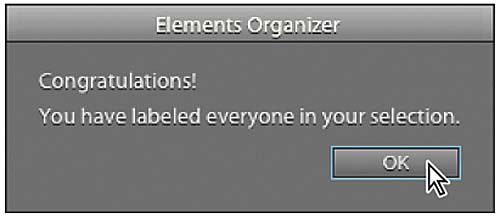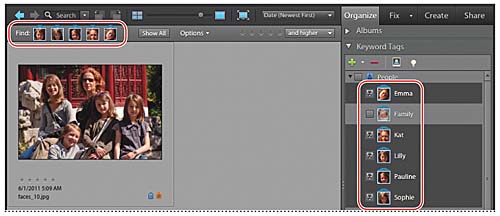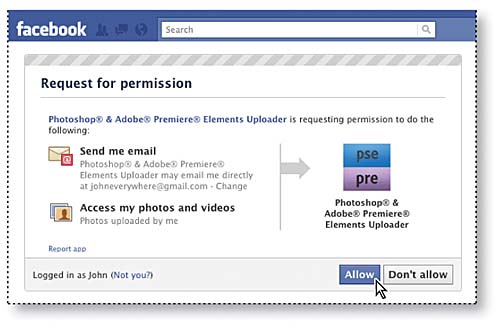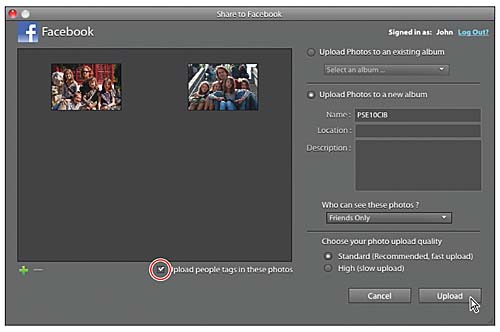- Getting started
- Getting photos
- Viewing photo thumbnails in the Organizer
- Working with star ratings and keyword tags
- Automatically finding faces for tagging
- Review questions
- Review answers
Automatically finding faces for tagging
Undoubtedly, your growing photo library will include many photos of your family and friends. Photoshop Elements 10 makes it quick and easy to tag your photos of friends and family members with the People Recognition feature, taking most of the work out of sorting and organizing a large portion of your catalog.
People Recognition automatically finds the people in your photos and makes it easy for you to tag them. Once you begin using the feature it learns to recognize the faces you’ve already tagged and will automatically tag new photos with those faces.
Using People Recognition
The first experience you’ll have of People Recognition will probably be the “Who Is This?” prompt that appears as you move the pointer over a photo in the single-image view in the Elements Organizer. People Recognition displays these hints to help you identify and tag all the people in your photos. You can ignore the hints if you wish, but remember that the more people you identify, the smarter People Recognition gets at tagging faces for you automatically.
The automatic “Who Is This” hints and the People Recognition feature itself can both be disabled. Before continuing, you need to make sure that both are activated. You can also import a few more images with faces for People Recognition to find.
- In the Organizer, choose Edit > Preferences > Media-Analysis (Windows) / Adobe Elements 10 Organizer > Preferences (Mac OS). In the Media-Analysis pane of the Preferences dialog box, make sure that the option Analyze Photos For People Automatically is activated. Click OK to save your settings and close the Preferences dialog box.
- In the View menu, make sure that Show People Recognition is activated.
- Choose File > Get Photos And Videos > From Files And Folders. In the Get Photos And Videos From Files And Folders dialog box, locate and open your Lesson02 folder; then, click once to select the Faces folder.
- Disable the options Automatically Fix Red Eyes and Automatically Suggest Photo Stacks. Click Get Media. In the Import Attached Keyword Tags dialog box, click Select All, and then click OK. Click OK to close any other alerts.
- Above the Media Browser, click the Show All button to display all the images in your CIB catalog, and then choose Date (Newest First) for the sorting order.
Tagging faces in the Media Browser
Photoshop Elements helps you with every step of the face tagging process.
- In the Media Browser, double-click the photo, faces_13.jpg, to see it in the enlarged single image view. Move the pointer over the image; white boxes appear over any faces detected in the photo. People Recognition has found three of the four faces in this picture. Move the pointer over any of the boxes; the “Who is this?” prompt appears.
- Starting with the girl at the left, click the “Who is this?” text in the black box, type the name Lilly, and then press Enter / return. Photoshop Elements creates a new keyword tag for Lilly. By default, the new tag appears in the People category in the Keyword Tags panel. Type Kat for the mother’s name and tag the girl on the right Pauline. Be sure to press Enter / return for each tag.
- Click the Add Missing Person
button (
 )
below the lower right corner
of the enlarged image. Drag
the new face tagging box
onto the face that was not
detected; use the handles around
the box to resize it so that
it surrounds the face neatly.
When you’re
done, click the green check
mark to confirm the position
of the box; then, type Emma in
the text box and press Enter
/ return.
)
below the lower right corner
of the enlarged image. Drag
the new face tagging box
onto the face that was not
detected; use the handles around
the box to resize it so that
it surrounds the face neatly.
When you’re
done, click the green check
mark to confirm the position
of the box; then, type Emma in
the text box and press Enter
/ return. - Click the left arrow key on your keyboard to move to the preceding photo. People Recognition already recognizes the girl on the right; click the green check mark to confirm the automatic tagging for Lilly. You haven’t yet tagged a photo of the other girl; type Sophie, and then press Enter / return.
- Move the pointer over the tagging box above Lilly’s head and click the X button at the upper right corner of the box to dismiss it; otherwise People Recognition will continue to register this as a person not yet named.
- You may find it a little difficult at first to work with the other extraneous tagging box, as it overlaps the boxes for both of the girls. Click in the “Who is this?” text to keep the box active while you move the pointer to the X button to dismiss it.
- Click the left arrow key on your keyboard to move to the preceding photo. This time, all five of the faces in the photo have been detected. Click in the “Who is this?” text box for the girl at the right of the frame. You haven’t yet tagged enough faces for People Recognition to identify this girl, but you’re offered a choice of possible tags from those available in the People category. Click the name Sophie, and then, if necessary, press Enter / return.
- Use the same technique to tag Lilly—the girl at the far left—and Pauline, beside her. Type Tom for the father’s name. Photoshop Elements doesn’t yet know the older girl well enough to offer the correct choice. Type the name Emma, and then press Enter / return. Dismiss the extra tagging box at the top of the stairs.
- Double-click the image to return the Media Browser to Thumbnail view.
People Recognition will sometimes incorrectly identify a chance arrangement of light and shadow in an image as a face. For this image, this has happened twice.
Tagging faces in batches
When you want to do some serious face tagging, rather than work through your catalog one image at a time, you can let People Recognition bulk-process your files.
- Reduce the size of the thumbnails so that you san see as many of the images in the Media Browser as possible. Ctrl-click / Command-click to select all of the photos of this family that have not yet been face-tagged—there are 27 in all.
- Click the Start People Recognition
button (
 )
at the top of the Keyword
Tags panel. The People Recognition – Confirm
Groups Of People dialog box
opens.
)
at the top of the Keyword
Tags panel. The People Recognition – Confirm
Groups Of People dialog box
opens. - For our example images, there are no images to be excluded from groups to be tagged Lilly and Pauline. Click Save to confirm these groups; then, click Save again to confirm the next sets to be tagged Emma and Sophie. Continue the process, dismissing the thumbnails of any faces of which you are unsure, until the People Recognition – Label People Dialog box appears.
- In the People Recognition - Label People dialog box, tag as many of the faces as you can. Be sure to press Enter / return whenever you type. When you’re done, click Save; then repeat the process for a new set of faces. Be patient—People Recognition is getting smarter with every click!
- Click the thumbnail of any face you recognize, and then click Save. If you click to include a face, you’ll be returned to the Label People dialog box to tag it. Images you ignore will no longer be seen as faces by People Recognition.
- Photoshop Elements will notify you when the tagging session is completed; click OK to dismiss the message and return to the Media Browser.
- In the keywords panel, activate the Find box beside the each of your new tags in turn, making sure to clear each search before starting the next. Try activating different combinations of Find boxes at the same time.
- To deactivate all of the keyword tag Find boxes and clear the search, click the Show All button above the thumbnails pane.
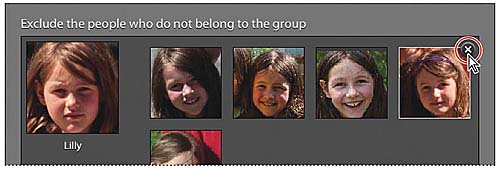
Figure 2-57 In Confirm Groups Of People mode, People Recognition collates groups of faces that match known names, and then offers you the option to exclude any faces that don’t belong. Click the X button at the top right of a face thumbnail to dismiss it.
People Recognition will alternate between the Confirm Groups and Label People modes, until eventually, you’ll be presented with a set of dimmed images like those in the illustration below. These may be faces obscured by shadows, hands, hats, or sunglasses—or sometimes just chance arrangements of color, light, and shadow with characteristics that have triggered the face recognition algorithms.
Sharing keyword tags with Facebook
If you have a Photoshop.com account, you can share your photos directly from Photoshop Elements to Facebook, complete with any tags you’ve applied in the Elements Organizer. Photoshop Elements can even download your friends list from Facebook, making it even easier to tag your photos.
- Make sure that you’re signed in to your Photoshop.com account (see “Creating an Adobe ID” in Lesson 1).
- Select the photos you wish to share selected in the Media Browser, click the Share tab at the top of the Task Pane, and then click Share To Facebook. If you are asked to confirm the action, click Yes.
- Photoshop Elements asks for your permission to access your Facebook account. Make sure that the option Download Facebook Friend List is activated, and then click Authorize.
- Facebook will also require your authorization. When the Facebook Request For Permission page opens in your default browser, click Allow; then, close the browser page and return to the Organizer.
- Click Complete Authorization. Photoshop Elements opens the Share To Facebook dialog box, where you can set up the details for your upload. Choose whether to upload photos to an existing Facebook album, or create and enter details for a new one. Specify who you wish to share your album to, and select an option for photo upload quality. You can add a photo to the selection to be uploaded, or exclude a picture, using the plus and minus buttons at the lower left of the preview pane. Make sure you activate the option Upload People Tags In These Photos, and then click Upload.
- When you’re done, click the Organise tab at the top of the Task pane to return to the Media Browser.
Photoshop Elements will download names from your Facebook friends list while your photos are being up-loaded. The next time you’re tagging photos in Photoshop Elements, you’ll notice that the names of your Facebook friends are offered as tagging suggestions.
You’ll be notified when the upload is complete and given the option to return to the Elements Organizer or visit your Facebook page to view your newly shared photos.
Congratulations, you’ve finished the lesson! You’ve imported files into the Elements Organizer using a variety of new techniques and learned several different ways to view and access the images in your catalog. You’ve also created, edited, and applied keyword tags to individual photographs so that they’ll be easy to find in future. Before you move on, take a few moments to review the concepts and techniques presented in this lesson by working through the following questions and answers.
